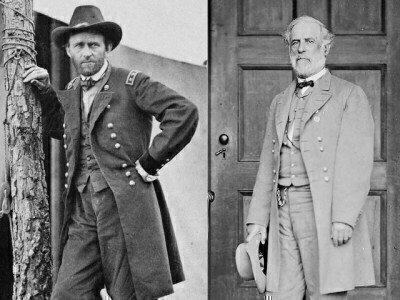The names Ulysses S. Grant and Robert E. Lee are connected through their Civil War bond and the historic surrender, 151 years ago today, at Appomattox Court House. But how much did Lee and Grant have in common?
 Both were noted military commanders and graduates of West Point. Beyond that here is a look at two legendary figures and their different paths to that day in 1865 that started the end of the Civil War.
Both were noted military commanders and graduates of West Point. Beyond that here is a look at two legendary figures and their different paths to that day in 1865 that started the end of the Civil War.
1. Robert E. Lee was among the bluest of Virginia blue bloods. The Lees were synonymous with the state and colony of Virginia. His father, “Light Horse” Harry Lee, fought with George Washington and gave the eulogy at Washington’s funeral.
2. Ulysses S. Grant was not a blue blood. Grant grew up in Ohio and his father was a tanner. Grant said his grandfather fought in the Revolutionary War at Bunker Hill.
3. The family of Lee’s future wife didn’t think he was good enough for her. When Lee made his intentions known to marry Mary Anna Custis, his future father-in-law objected, because Light Horse Harry Lee had fallen on hard times. Eventually, the Custis family relented. Mary Anna Custis was also Martha Washington’s great-granddaughter.
4. Ulysses wasn’t Grant’s first name. The future general and president was born Hiram Ulysses Grant in Point Pleasant, Ohio. A mistake was made on his application to West Point by a congressman who nominated Grant, who listed his name as Ulysses S. Grant.
5. Robert E. Lee graduated second in his class at West Point. He was called the “Marble Model” because of his drive and focus at the military academy.
6. Grant was an average student at West Point. Coming from humble backgrounds, Grant struggled with some courses at the academy, but he astounded his classmates with this ability as a horseman.
7. Lee’s star was continually rising in the U.S. military. First as an engineer and then as a tactical commander under Winfield Scott in the Mexican-American War. In 1852, Lee was named as superintendent of West Point.
8. Grant struggled with his first military career. Although he also fought with distinction in the Mexican-American War, Grant was moved to several military posts and resigned from the Army in 1854 without explanation.
9. Lee was briefly in the United States army at the Civil War’s start. After the war started on April 12, 1861, Lee was offered command of the United States army. But Lee resigned his army commission on April 20, and he accepted command of Confederate troops in Virginia.
10. Grant had to earn his military place in the Civil War. He was first appointed to train a volunteer regiment in Illinois. After tackling more difficult tasks, Grant won major victories at Fort Henry and Fort Donelson in February 1862, and he became a national figure known as “Unconditional Surrender” Grant.







